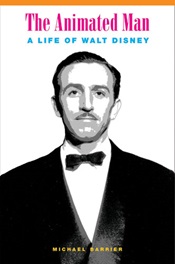(University of California Press, 411 pages, $29.95)
By Michael Barrier
 Coming in wake of Neal Gabler’s recent, massive biography of Walt Disney, Michael Barrier’s The Animated Man may appear, at first glance, slightly redundant. In fact, it’s more a matter of luck and timing, and the earlier work detracts in no way from the decades of original research that underpin Barrier’s book. Gabler’s tome saw Disney as an American icon, a man who foresaw the world we live in now, or at least devised the blueprint for much of it by establishing his name as an instantly identifiable brand, creating the world as a theme park and practically inventing tie-in merchandising. Barrier’s ambitions are simpler yet more difficult to achieve, but he has at hand a weapon that even the Disney-authorized Gabler lacked. Barrier’s nearly lifelong project has been the ongoing history of American animation. In the 1970s, he was the founder and editor of the animation magazine Funnyworld, and spent over 25 years compiling priceless interviews with pioneering animators—especially those at Disney—all of whom are long dead. Some of this material formed the basis of his book, Hollywood Cartoons: American Animation in Its Golden Age, published in 1999. This enormous catalogue of information forms the bedrock of The Animated Man. As the title suggests, Barrier is interested in Disney as a pioneer of the art that was indelibly associated with his name, from the release of the hugely successful Snow White and the Seven Dwarfs in 1937. He concentrates less on Disney’s supposed shortcomings as a man than on the haphazard, improvisatory manner in which he and his partners took a fledgling form of filmic entertainment and turned it into a functioning worldwide industry. At the forefront of this account is Barrier’s deep knowledge of the technical development of animation and Disney’s place within it, backed by original interviews with people who often were in the room with Disney when he was making his groundbreaking art. The accounts of matching sync-sound to the images of Steamboat Willie in 1928 and the years-long, Herculean labors that brought forth Snow White are as compelling as they are detailed. And Barrier is an intent and scrupulous biographer of the man, finding Disney a bit elusive behind his workaholic tendencies and relentless optimism. Barrier takes note of Disney’s increasing political conservatism, especially after the animators’ strike of 1941, and yet ably refutes—as does Gabler—Disney’s reputation as an anti-Semite. Sympathetic, well-proportioned and elegantly written, The Animated Man may one day prove the sturdier, more lasting biography.
Coming in wake of Neal Gabler’s recent, massive biography of Walt Disney, Michael Barrier’s The Animated Man may appear, at first glance, slightly redundant. In fact, it’s more a matter of luck and timing, and the earlier work detracts in no way from the decades of original research that underpin Barrier’s book. Gabler’s tome saw Disney as an American icon, a man who foresaw the world we live in now, or at least devised the blueprint for much of it by establishing his name as an instantly identifiable brand, creating the world as a theme park and practically inventing tie-in merchandising. Barrier’s ambitions are simpler yet more difficult to achieve, but he has at hand a weapon that even the Disney-authorized Gabler lacked. Barrier’s nearly lifelong project has been the ongoing history of American animation. In the 1970s, he was the founder and editor of the animation magazine Funnyworld, and spent over 25 years compiling priceless interviews with pioneering animators—especially those at Disney—all of whom are long dead. Some of this material formed the basis of his book, Hollywood Cartoons: American Animation in Its Golden Age, published in 1999. This enormous catalogue of information forms the bedrock of The Animated Man. As the title suggests, Barrier is interested in Disney as a pioneer of the art that was indelibly associated with his name, from the release of the hugely successful Snow White and the Seven Dwarfs in 1937. He concentrates less on Disney’s supposed shortcomings as a man than on the haphazard, improvisatory manner in which he and his partners took a fledgling form of filmic entertainment and turned it into a functioning worldwide industry. At the forefront of this account is Barrier’s deep knowledge of the technical development of animation and Disney’s place within it, backed by original interviews with people who often were in the room with Disney when he was making his groundbreaking art. The accounts of matching sync-sound to the images of Steamboat Willie in 1928 and the years-long, Herculean labors that brought forth Snow White are as compelling as they are detailed. And Barrier is an intent and scrupulous biographer of the man, finding Disney a bit elusive behind his workaholic tendencies and relentless optimism. Barrier takes note of Disney’s increasing political conservatism, especially after the animators’ strike of 1941, and yet ably refutes—as does Gabler—Disney’s reputation as an anti-Semite. Sympathetic, well-proportioned and elegantly written, The Animated Man may one day prove the sturdier, more lasting biography.
Review written by John Patterson.